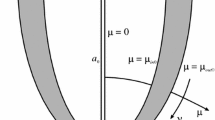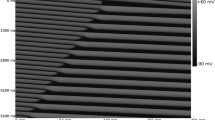Abstract
A phase variable that uniquely represents the time course of the action potential has been used to study the mechanisms of cardiac fibrillation. A spatial phase singularity (PS) occurs during reentrant wave propagation and represents the organizing center of the rotating wave. Here, we present an error analysis to investigate how well PSs can be localized. Computer simulations of rotating spiral waves scaled appropriately for cardiac tissue were studied with various levels of noise added. The accuracy in identifying and localizing singularities depended on three factors: (i) the point chosen as the origin in state space used to calculate the phase variable; (ii) signal to noise ratio; and (iii) discretization (number of levels used to represent data). We found that for both simulation as well as experimental data, there existed a wide range for the choice of origin for which PSs could be identified. Discretization coupled with noise affected this range adversely. However, there always existed a range for choice of the origin that was 20% or more of the action potential amplitude within which the accuracy of localizing PSs was better than 2 mm. Thus, a precise determination of origin was not necessary for accurately identifying PSs. © 2001 Biomedical Engineering Society.
PAC01: 8719Nn, 8710+e, 8719Hh
Similar content being viewed by others
REFERENCES
Aliev, R. R., and A. V. Panfilov. A simple two-variable model of cardiac excitation. Chaos, Solitons Fractals 7:293–301, 1996.
Athill, C. A., T. Ikeda, Y. Kim, T. Wu, M. C. Fishbein, H. S. Karagueuzian, and P. Chen. Transmembrane potential properties at the core of functional reentrant wave fronts in isolated canine right atria. Circ. Res. 98:1556–1567, 1998.
Banville, I., R. A. Gray, R. E. Ideker, and W. M. Smith. Shock-induced figure-of-eight reentry in the isolated rabbit heart. Circ. Res. 85:742–752, 1999.
Bar, M., and M. Eiswirth. Turbulence due to spiral wave breakup in a continuously excitable medium. Am. Physiol. Soc. 48:1635–1637, 1993.
Baxter, W. T., J. M. Davidenko, L. M. Leow, J. P. Wuskell, and J. Jalife. Technical features of a CCD video camera system to record cardiac fluorescence data. Ann. Biomed. Eng. 25:713–725, 1997.
Beeler, G. W., and H. Reuter. Reconstruction of the action potential of ventricular myocardial fibers. J. Physiol. (London) 268:177–210, 1977.
Cinelli, A. R., S. R. Neff, and J. S. Kauer. Salamander olfactory bulb neuronal activity observed by video rate, voltage-sensitive dye imaging. I. Characterization of the recording system. J. Neurophysiol. 73:2017–2032, 1995.
Courtemanche, M. Complex spiral wave dynamics in a spatially distributed ionic model of cardiac electrical activity. Chaos 6:579–599, 1996.
Drouhard, J., and F. A. Roberge. Revised formulation of the Hodgkin-Huxley Representation of the sodium current in cardiac cells. Comput. Biomed. Res. 20:333–350, 1987.
Ebihara, L., and E. A. Johnson. Fast sodium current in cardiac muscle: A quantitative description. Biophys. J. 32:779–790, 1980.
FitzHugh, R. Pulses and physiological states in theoretical models of nerve membrane. Biophys. J. 1:445–466, 1961.
Garfinkel, A., P. S. Chen, D. O. Walter, H. S. Karagueuzian, B. Kogan, S. J. Evans, M. Karpoukhin, C. Hwang, T. Uchida, M. Gotoh, O. Nwasokwa, P. Sager, and J. N. Wiess. Quasiperiodicity and chaos in cardiac fibrillation. J. Clin. Invest. 99:305–314, 1997.
Gray, R. A., and Banville, I. Video imaging of fibrillation and defibrillation. In: Quantitative Cardiac Electrophysiology, edited by C. Cabo and D. S. Rosenbaum. New York: Marcel Dekker (in press).
Gray, R. A., and Jalife, J. Video imaging of cardiac fibrillation. In: Optical Mapping of Cardiac Excitation and Arrhythmias, edited by D. S. Rosenbaum and J. Jalife, New York: Futura (in press).
Gray, R. A., J. Jalife, A. V. Panfilov, W. T. Baxter, C. Cabo, J. M. Davidenko, and A. M. Pertsov. Mechanisms of cardiac fibrillation. Science 270:1222–1223, 1995.
Gray, R. A., M. P. Arkady, and J. Jalife. Spatial and temporal organization during cardiac fibrillation. Nature (London) 392:75–78, 1998.
Ikeda, T., T. Uchida, D. Hough, J. J. Lee, M. C. Fishbein, W. J. Mandel, P. S. Chen, and H. S. Karagueuzian. Mechanism of spontaneous termination of functional reentry in isolated canine right atrium. Circ. Res. 94:1962–1973, 1996.
Kuramoto, Y. Chemical Oscillations, Waves and Turbulence. Berlin: Springer, 1984.
Luo, C. H., and Y. Rudy. A dynamic model of the cardiac ventricular action potential. Circ. Res. 74:1097–1113, 1994.
Myerburg, R. J., K. M. Kessler, A. Interian, Jr., P. Fernandez, S. Kimura, P. L. Kozlovskis, T. Furukawa, A. L. Bassett, and A. Castellanos. Clinical and experimental patho-physiology of sudden cardiac death. Cardiac Electrophysiology, From Cell to Bedside. Philadelphia: W. B. Saunders, 1990.
Nagumo, J. S., S. Arimoto, and S. Yoshizawa. An active pulse transmission line simulating nerve axon. Proc. IRE 50:2061, 1962.
Pertsov, A. M., J. M. Davidenko, R. Salomonsz, W. T. Baxter, and J. Jalife. Spiral waves of excitation underline reentrant activity in isolated cardiac muscle. Circ. Res. 72:631–650, 1992.
Takens, F. Detecting strange attractors in turbulence. In Dynamical Systems and Turbulence, edited by D. A. Rand and L. S. Young. Lect. Notes Math. 898:366–381, 1981.
Winfree, A. T. When Time Breaks Down. Princeton: Princeton University Press, 1987.
Winfree, A. T. Varieties of spiral wave behavior: An experimentalist's approach to the theory of excitable media. Chaos 1:303–334, 1991.
Witkowski, F. X., K. M. Kavanagh, P. A. Penkoske, R. Plonsey, M. L. Spano, W. L. Ditto, and D. T. Kaplan. Evidence for determinism in ventricular fibrillation. Phys. Rev. Lett. 75:1230–1233, 1995.
Author information
Authors and Affiliations
Rights and permissions
About this article
Cite this article
Iyer, A.N., Gray, R.A. An Experimentalist's Approach to Accurate Localization of Phase Singularities during Reentry. Annals of Biomedical Engineering 29, 47–59 (2001). https://doi.org/10.1114/1.1335538
Issue Date:
DOI: https://doi.org/10.1114/1.1335538




